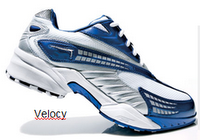Faster Running
I received two emails this week from triathletes who wanted to know how they could become faster runners. One believed it could be done simply by knowing a few key workouts to do. I wish it was so simple. There are no magic workouts to make you a fast runner. In fact, you can take a fast runner and have him/her do exactly the 'wrong' workouts and he/she will still run fast.
The best runner I ever coached was Ryan Bolton. He was an All-American runner at the University of Wyoming who moved to triathlon after graduation. In college he ran sub-30 minutes for 10k. Pretty good for a triathlete. He went on to make the US Olympic Triathlon team in 2000 and won Ironman USA in 2002.
If I could create the perfect runner starting with a youngster I would do it just as Ryan did growing up. In grade school he ran sprints and was fast. In junior high school he moved up to the 800 meters. In high school he ran the mile and two mile. And in college he ran 5000. He didn't start trying to run as far as he could slowly. Just the opposite. He started out running short distances very fast and over several years lengthened the races, but still ran fast.
One of those triathletes who wrote me about wanting to run faster this season told me she had entered a marathon as she believed that as the way to run faster. I hated to burst her bubble but I told her that I thought this was exactly the wrong thing to do. Running slowly for a long time doesn't make you a faster runner. It only makes you good at running slowly for a long time.
I told her that the starting point for becoming faster was to decide what was standing between her and faster running--her run limiter. For most runners that starting place for limiters is usually some combination of running posture, cadence and footstrike. Posture is tall, head in a neutral position (not looking down) with a slight S-shape from the spine through the legs. Cadence is at least 88 rpm at all times--even when running slowly (count your right foot strikes for one minute). Most age group runners are around 78 to 84 rpm. That means a lot of loping with vertical oscillation. Footstrike is flat or midsole, however you best visualize it. It is definitely not back on the heels as probably 80% of all runners land. It is also not on the toes or ball of the foot with the heel off the ground. For some reason, that is what most runners think they are supposed to do when they make the change. The best drill for learning to flat foot strike is the 'paw-back' drill. Aggresively pull the foot backwards to the ground on each stride until it becomes habitual and effort or thought is no longer necessary (actually, the foot doesn't move backwards when pawing back--it decelerates, but I don't want to get too deep into thinking about the details here). Land on the flat or midsole of your foot. You can't put your foot down too soon. For more details on this see my blog entry below .
Once all three of these are optimized then it's time to start thinking about workouts that will help you get faster. These will almost always be short intervals at first--less than two minutes duration with long recoveries (at least two minutes). Then just as a young runner would do as he/she matures, the intervals get longer until one is doing six- to twelve-minute intervals with short recoveris--fast! This entire process could take a year or two. There are no shortcuts to realizing your potential as an athlete.
To see a video clip of Ryan Bolton running go here. Please note his posture, cadence and footstrike. Slow it down and pause frequently to see how his foot contacts the ground. Notice that his foot is always below his knee--not out in front--at foot strike. This is what you should be striving for. With a little dedication to technique and a steady approach to improvement you can eventually run as smoothly as he does.



